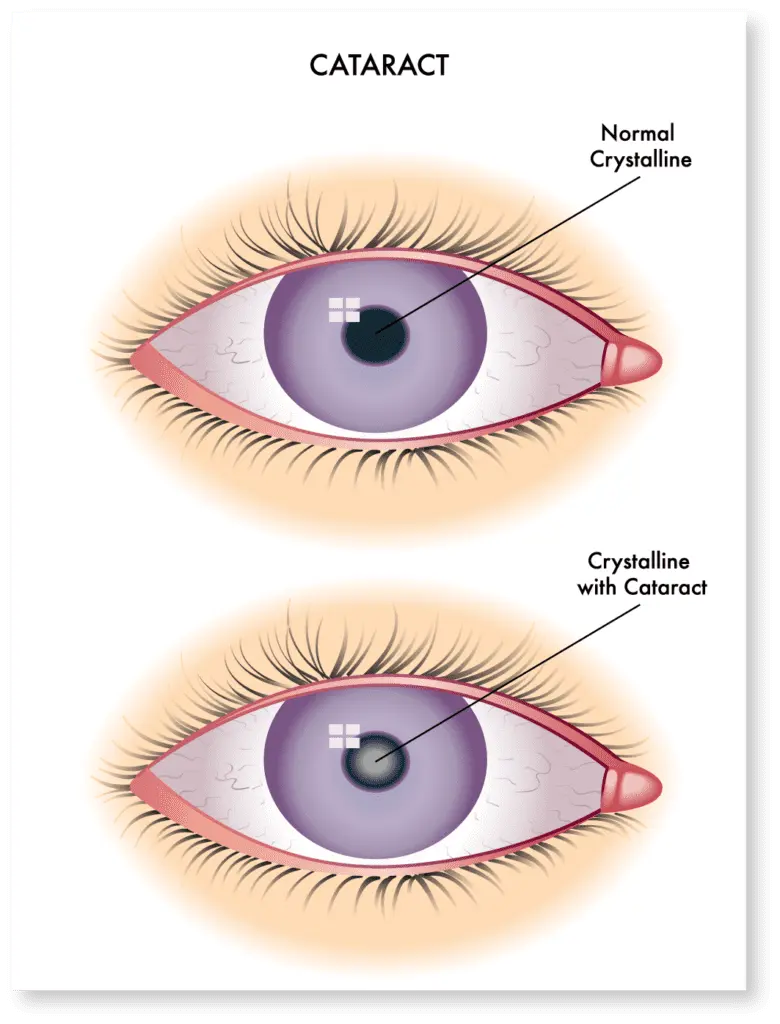Keratoconus Treatment In Lucknow
Keratoconus is a progressive eye condition where the cornea, which is typically dome-shaped, gradually thins and bulges into a cone-like shape. This alteration in shape affects how light enters the eye, leading to distorted vision. Initially, individuals might notice blurred or distorted vision, sensitivity to light, and increased nearsightedness or astigmatism.
It usually begins in the teenage years or early 20s and can progress over time. The exact cause isn’t entirely clear, but factors like genetics, eye rubbing, and certain conditions like allergies might contribute.

Symptoms of cataracts may include:
- Blurry, cloudy, or dim vision
- Sensitivity to light and glare
- Difficulty seeing at night
- Seeing halos around lights
- Fading or yellowing of colors
- Double vision in a single eye

Cataract Surgery
Cataract surgery is a common and safe procedure performed to treat cataracts, which cause cloudy vision due to the opacification of the eye’s natural lens. Here’s an overview of the cataract surgery process:
- Consultation: You’ll have a comprehensive eye exam to assess the cataract’s severity, overall eye health, and discuss treatment options.
- Biometry: Measurements of the eye are taken to determine the appropriate power of the intraocular lens (IOL) that will replace the cloudy natural lens.
- Anesthesia: Cataract surgery is usually done under local anesthesia. You’ll likely be awake during the procedure, but the eye will be numbed to prevent discomfort.
- Incision: A small incision is made in the eye, often less than 3 millimeters in size.
- Lens Removal: Using a technique called phacoemulsification, the cloudy lens is broken into tiny pieces with ultrasound and removed from the eye.
- IOL Placement: An artificial intraocular lens (IOL) is then inserted into the eye to replace the removed natural lens. The IOL remains permanently in place, correcting vision after the surgery.
- Stitching: In most cases, no stitches are needed for the incision to heal. Self-sealing incisions usually close on their own.
- Rest: You may need some time to rest after the surgery, but recovery is generally quick.
- Eye Drops: Prescribed eye drops help prevent infection and aid in healing.
- Follow-up Visits: Regular check-ups with your ophthalmologist are necessary to monitor the healing process and ensure good vision recovery.
- Resume Normal Activities: Most people can resume normal activities within a few days to a week after surgery.
- Improved Vision: Many patients experience significant improvement in vision shortly after surgery, with clearer and sharper vision over time.
- Reduced Dependence on Glasses: Depending on the IOL used, some patients may need glasses for certain tasks, while others might experience reduced dependence on glasses for distance or near vision.
FAQ
The duration of cataract surgery itself is relatively short, typically lasting around 15 to 30 minutes per eye. However, the entire process—from pre-surgery preparation to post-operative care—takes a few hours on the day of the surgery.
Cataract surgery can be performed on both eyes, but it’s not typically done simultaneously in the same surgical session. Generally, cataract surgery is done on one eye at a time, usually with a gap of a few days to a few weeks between surgeries.
There are several reasons for this approach:
Reduced Risk: Performing surgery on one eye at a time lowers the risk associated with complications that might affect both eyes simultaneously.
Healing and Recovery: Allowing time between surgeries allows for proper healing and recovery of the first eye before the second eye is operated on. This reduces the strain of adjusting to changes in vision for daily activities.
Monitoring: By performing surgeries separately, the surgeon and patient can better monitor the progress and recovery of each eye independently.
Risk Management: In the rare event that complications arise, having the surgeries spaced apart allows for better management and avoids potential risks affecting both eyes at once.
Cataract surgery is generally considered safe and has a high success rate. However, like any surgical procedure, there are potential risks and complications, although they are relatively rare. Some complications that can occur after cataract surgery include:
- Infection
- Swelling or Inflammation
- Posterior Capsule Opacification (PCO)Dislocated or Displaced Intraocular Lens (IOL)
- Retinal Detachment
- Glaucoma
- Corneal Edema
- Persistent Swelling or Pain
Cataracts cannot be treated or reversed with medicines, yoga, or eye exercises. Once a cataract forms, surgical removal is the only effective treatment to restore clear vision.
While a healthy lifestyle, including proper nutrition and regular exercise, is beneficial for overall eye health, these practices do not reverse or cure cataracts. However, they might help in reducing the risk of developing cataracts or delaying their progression:
- Healthy Diet
- UV Protection
- Quitting Smoking
- Regular Eye Check-ups
